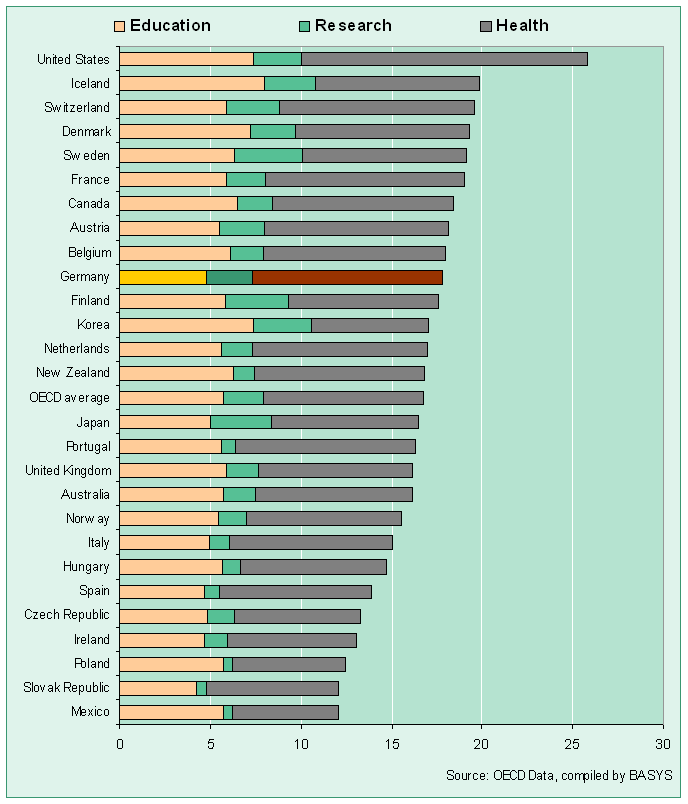| Title | Expenditures for Human Capital Development |
| Date | September 2010 |
| Authors | Markus Schneider |
The well-being of future generations will depend not only upon how much stock of exhaustible resources we leave to them but also how much we devote to the constitution of the human capital, essentially through expenditure on education, research, and health, but also through culture and social inclusion. All industrial countries invest a substantial proportion of national income in human capital development. Taking into account both public and private sources of funds, OECD countries had spend 16.8% of their Gross Domestic Product, on average in 2006, on human capital, defined as spending for education, research, and health together
The size and composition of human capital expenditures for all types of investments differs considerably across countries. The United States of America devoted by far the highest share of their GDP to human capital spending. In total, 26% of GDP was used for expenditures on education, research, and health services and goods. Relatively to the GDP, the United States spends two times more on human capital development than Mexico. In Europe, the Slovak Republic and Poland show the lowest proportion (12% and 13,1%).

Figure: Human Capital Expenditures as % of GDP, 2006
A range of factors, particularly national allocation systems for public budgets, influences the allocation of expenditures for human capital. Public expenditures for health compete with other public expenditures as expenditures for defence, security, culture, social benefits, infrastructure, and social benefits. The actual allocation depends particularly on the structure of institutions deciding upon the allocation. Institutions matter: institutions define the rules of the game, which determines the distribution of public expenditures (North 1990). One might ask, which institutions? Why gives Germany health care a higher rank than education? In fact, Germany exhibits the lowest share of human capital expenditure on education as % of total human capital expenditures, only 27% as compared to 34% across OECD countries.
In 2006, health care accounted for 53% of total human capital spending on average across OECD countries. Expenditure on education accounted for 34% and expenditure on research for 13% on average. Various economic and social investigations indicate that the composition of human capital spending matters for economic performance and wellbeing.
Investment in human capital is also a critical factor for economic growth, for the simple reason that this growth is, more than ever, based on technical advances that demand workers always more skilled and qualified. Investment in human capital also delivers social returns, such as higher life-expectancy for more educated people, lower undesired fertility in less-developed countries, and greater participation in civic and social life (Stiglitz, Sen, Fitoussi 2009). There is compelling evidence of a correlation between education and health. In European countries, the mortality rates of less-educated men are, on average, 50% higher than those of more-educated men, while the difference is 30% for women (Mackenbach, 2006). The relation between education and health holds both for serious health problems, such as diabetes and high blood pressure, and for more common illnesses, such as colds, headaches and aches and pains from other causes (Stone et al., 2008). Better-educated individuals generally have better health, which lowers public expenditure on provision of health care and thus public expenditure. As individual incomes generally rise with educational attainment, there is more consumption of goods and services among the more educated, and this gives rise to fiscal effects beyond income tax and social security contributions. However, tax and expenditure data on these indirect effects of education are not readily available for inclusion in rate-of-return calculations.
The boundaries of what is conventionally labelled as human capital are not always well defined. The formal education system obviously plays a critical role in sustaining the accumulation of human capital, but this accumulation can also reflect learning processes developed outside schools, such as early childhood education and on-the job training. Health is an essential part of human capital and the challenges posed by its development are closely connected to those relating to skills and competences.
In Germany, it is time to reflect on a broader strategy to develop human capital and the priorities within the public budgets. Globalisation has increased the demand for high-skilled labour significantly. There are already indications of broad-based shortages of skilled labour ahead of the economic crisis that will lead to constraints of growth in at least some sectors. Therefore, among others not only tertiary graduation rates needs to be lifted to further develop human capital in Germany.



